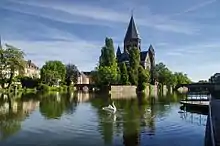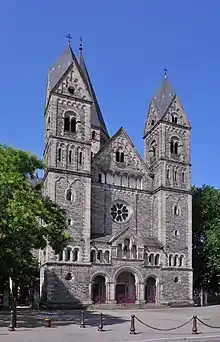| Temple Neuf | |
|---|---|
Neue evangelische Kirche | |
 View from rue des Roches | |
| 49°07′14″N 06°10′19″E / 49.12056°N 6.17194°E | |
| Location | Place de la Comédie, Metz |
| Country | France |
| Denomination | Protestant Reformed Church of Alsace and Lorraine |
| History | |
| Status | Active |
| Architecture | |
| Architect(s) | Conrad Wahn[1] |
| Style | Romanesque Revival architecture[2] |
| Years built | 1901–1904[1][2] |
| Specifications | |
| Capacity | 1,200[2] |
| Length | 53 metres (174 ft)[2] |
| Width | 26 metres (85 ft)[2] |
| Number of domes | 1 |
| Dome height (outer) | 55 metres (180 ft)[2] |
| Designated | 1930[3] |
| Reference no. | PA00106919[3] |
Temple Neuf (French pronunciation: [tɑ̃pl nœf], meaning "New Temple") is a Protestant church in Metz, France. It is located on place de la Comédie (next to Opéra-Théâtre),[3] at the center of the Jardin d'Amour on the southwestern edge of Île du Petit-Saulcy, which is surrounded by the Moselle.

The church was built by Glod, with the first stone being laid on 25 November 1901 (when Metz was a part of the German Empire),[2] following plans by architect Conrad Wahn.[1] It was inaugurated as the Neue evangelische Kirche on 14 May 1904 in the presence of Wilhelm II, German Emperor, and his wife Augusta Victoria of Schleswig-Holstein.[2] The church is an example of Romanesque Revival architecture,[2] and has been a monument historique of France since 1930.[3]
References
- 1 2 3 Pierre Bronn (2007). Le Protestantisme en Pays Messin: Histoire et lieux de mémoire (in French). p. 190. ISBN 9782876927148.
- 1 2 3 4 5 6 7 8 9 "Metz : quand Guillaume II défilait jusqu'au Temple neuf". Le Républicain Lorrain (in French). 22 January 2018.
- 1 2 3 4 Base Mérimée: Temple protestant, Ministère français de la Culture. (in French)
External links
![]() Media related to Temple neuf de Metz at Wikimedia Commons
Media related to Temple neuf de Metz at Wikimedia Commons
- Le Temple Neuf (in French)
- Paroisse de Metz – Temple Neuf (in French)